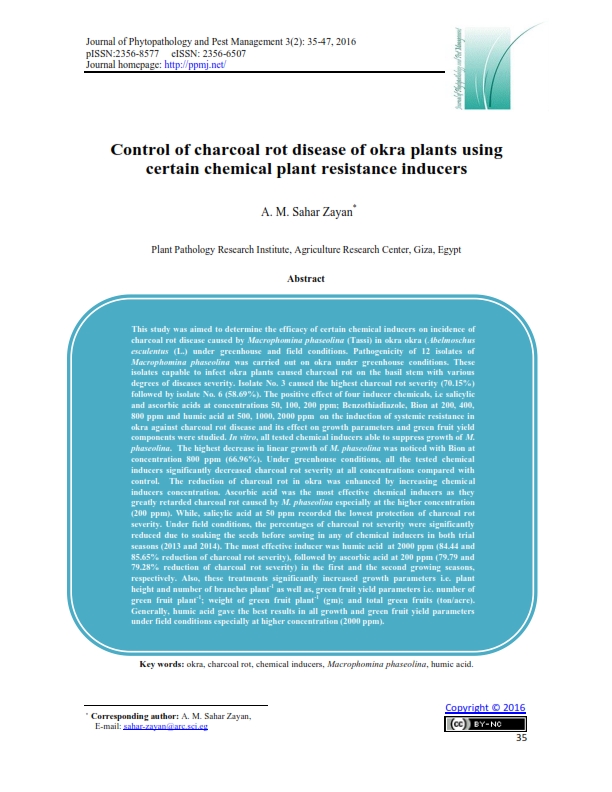Control of charcoal rot disease of okra plants using certain chemical plant resistance inducers
Keywords:
okra, charcoal rot, chemical inducers, Macrophomina phaseolina, humic acid.Abstract
This study was aimed to determine the efficacy of certain chemical inducers on incidence of charcoal rot disease caused by Macrophomina phaseolina (Tassi) in okra okra (Abelmoschus esculentus (L.) under greenhouse and field conditions. Pathogenicity of 12 isolates of Macrophomina phaseolina was carried out on okra under greenhouse conditions. These isolates capable to infect okra plants caused charcoal rot on the basil stem with various degrees of diseases severity. Isolate No. 3 caused the highest charcoal rot severity (70.15%) followed by isolate No. 6 (58.69%). The positive effect of four inducer chemicals, i.e salicylic and ascorbic acids at concentrations 50, 100, 200 ppm; Benzothiadiazole, Bion at 200, 400, 800 ppm and humic acid at 500, 1000, 2000 ppm on the induction of systemic resistance in okra against charcoal rot disease and its effect on growth parameters and green fruit yield components were studied. In vitro, all tested chemical inducers able to suppress growth of M. phaseolina. The highest decrease in linear growth of M. phaseolina was noticed with Bion at concentration 800 ppm (66.96%). Under greenhouse conditions, all the tested chemical inducers significantly decreased charcoal rot severity at all concentrations compared with control. The reduction of charcoal rot in okra was enhanced by increasing chemical inducers concentration. Ascorbic acid was the most effective chemical inducers as they greatly retarded charcoal rot caused by M. phaseolina especially at the higher concentration (200 ppm). While, salicylic acid at 50 ppm recorded the lowest protection of charcoal rot severity. Under field conditions, the percentages of charcoal rot severity were significantly reduced due to soaking the seeds before sowing in any of chemical inducers in both trial seasons (2013 and 2014). The most effective inducer was humic acid at 2000 ppm (84.44 and 85.65% reduction of charcoal rot severity), followed by ascorbic acid at 200 ppm (79.79 and 79.28% reduction of charcoal rot severity) in the first and the second growing seasons, respectively. Also, these treatments significantly increased growth parameters i.e. plant height and number of branches plant-1 as well as, green fruit yield parameters i.e. number of green fruit plant-1; weight of green fruit plant-1 (gm); and total green fruits (ton/acre). Generally, humic acid gave the best results in all growth and green fruit yield parameters under field conditions especially at higher concentration (2000 ppm).
Metrics

Published
How to Cite
Issue
Section
License
Authors who publish with Journal of Phytopathology and Disease Management agree to the following terms:
- Authors retain copyright and grant the journal right of first publication with the work simultaneously licensed under a Creative Commons Attribution License that allows others to share the work with an acknowledgement of the work's authorship and initial publication in this journal.
- Authors retain copyright and grant the journal right of first publication with the work simultaneously licensed under the Creative Commons Attribution-Non Commercial License (CC BY-NC). This allows others to share the work with an acknowledgement of the work's authorship and initial publication in this journal.
- Archives of Agricultural Sciences Journal is an Open Access Journal, and articles published are distributed under the terms of the Creative Commons Attribution-Non Commercial License (CC BY-NC). Readers may copy, distribute, and display the work for non commercial purposes with the proper citation of the original work. However, the journal retains the right to exploit subsidiary rights on behalf of the authors.
- Authors are able to enter into separate, additional contractural arrangements for the non-exclusive distribution of the journal's published version of the work (e.g. post it to an institutional repository or publish it in a book), with an acknowledgement of its initial publication in this journal.
- Authors are permitted and encouraged to post their work online (e.g., in institutional repositories or on their website) prior to and during the submission process with full disclosure to the journal, as it can lead to productive exchanges, as well as earlier and greater citation of published work. Following publication in Archives of Agricultural Sciences Journal, the author should update the repository, and include a citation and link to the published work.
Click here for more information on Licensing policy
.png)




